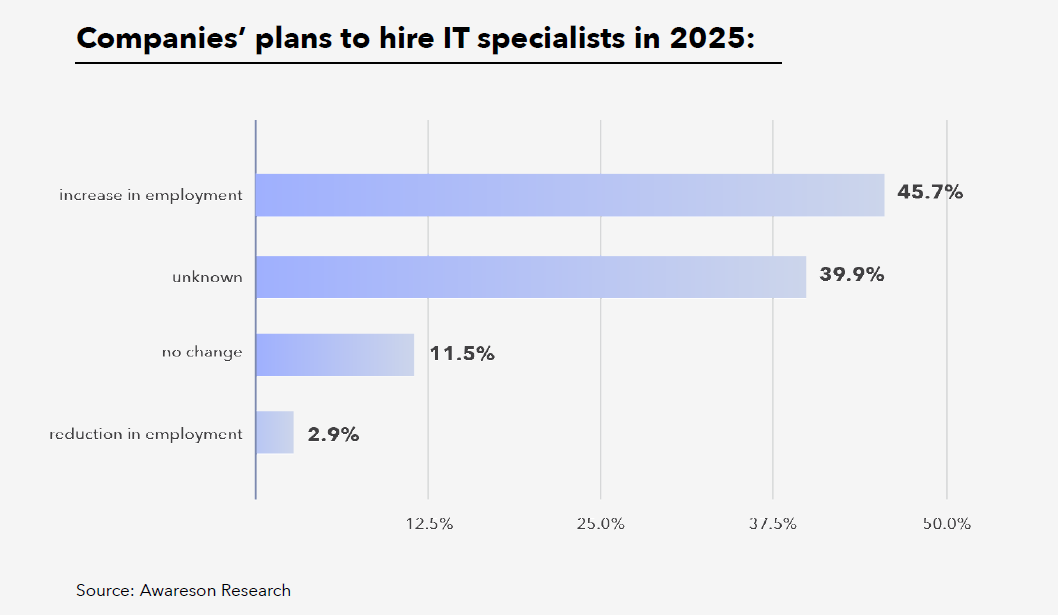IT specialist turnover – 2025 report

The challenging economic environment and the abrupt tightening of the ‘money tap’ for technological investments in the USA, had a clear impact on the Polish market. Nearly 1/5 of the companies surveyed by Awareson reduced the size of their teams in 2024, which aligned with our forecasts from a year ago. This turned the IT job market upside down: with a multitude of juniors who entered the market in 2020-2022 being left without jobs and prospects.

As many as one-third of those managers who planned new recruitments a year ago, had to put them on hold. Those who decided to hire had the luxury of choosing from several experienced candidates. The most sought-after skills were in data, security, automation, and certain ERP systems.

As the quarters passed by, there were increasing signs of a market recovery. Job offers increased, and over 72% of surveyed managers planned new projects. However, uncertainty remained high. Nearly 40% of IT and HR leaders were unsure about the composition of their teams in the coming year. These are not ideal conditions for planning future recruitment. The indecisive managers could both hire and lay off employees. Both scenarios present new challenges for HR departments, and preparing for both possibilities makes the job more difficult. What about the candidates? Nearly 35% of them changed jobs last year. This is a level similar to previous years.

The reasons for turnover are changing, however. Only in 62% of cases was the decision to change jobs due to the specialist – a year ago this percentage was over 72%. It is clear that lay-offs are not a myth, and that they have mostly affected juniors.
Employee turnover is a global and growing problem that has been escalating for years, and employers need to get used to it.

Increasingly, representatives of “Generation Z” in the workforce are declaring that they plan to change jobs more frequently than their older colleagues. According to Gallup, 52% of respondents plan to change jobs in 2025 (compared to 51% the previous year). In Europe, this rate is the lowest in the world at 32% (down from 34% the year before). It’s no surprise, therefore, that HR specialists are paying more attention to stabilising teams within their organisations. This trend impacts on recruitment strategies, employee engagement methods, and the analysis of why people are leaving their jobs.
This year, the Polish IT sector stands out from this trend, but it’s an exception to the rule, influenced by last year’s layoffs and increased turnover during the pandemic. Fewer companies are hiring, carefully selecting candidates, and last year’s lay-offs have shown that it’s worth “sticking with” an organisation if it provides a sense of security.
There are signals in the IT job market suggesting that companies in this sector are planning to hire again. It seems that the wave of mass lay-offs at tech giants is behind us. Now is the time to align staffing levels with actual needs. IT has always been at the forefront of innovations and technological trends. It’s no surprise that areas such as AI, cloud computing, cybersecurity, and data are expected to generate new jobs within companies. Many of these areas have been hot topics for some time now. However, there is a shift in the approach to recruitment and candidate requirements. Increasingly, attention is being paid to soft skills, especially communication, problem-solving, and teamwork. When combined with the growing demand for experienced or highly experienced candidates (mid and senior levels), the ideal candidate profile emerges: someone who can solve problems effectively in collaboration with others and possesses a broad range of competencies that extend beyond narrow specialisation.
Moreover, there is a noticeable decrease in the tendency for frequent job changes, further proof that the IT job market is stabilising.
Krzysztof Kempiński
author of the podcast “Porozmawiajmy o IT”, SOLID.Jobs
This market correction presents an opportunity to improve the recruitment process ahead of the next wave of hiring. So, key questions abound: Are we defining the role effectively with the hiring manager? Are our decisions aligned with the realities of the market? Is our process optimised?
If we want to shorten, streamline, or improve how we assess candidates’ motivations, now might be the perfect time. It’s also a good idea to re-visit recent exit interviews to avoid repeating past mistakes when hiring new
employees. Soon, there might not be time to do this.

Want to know more? Download the full IT job market report, 2025.
DOWNLOAD REPORT



